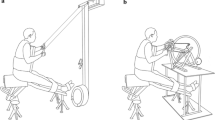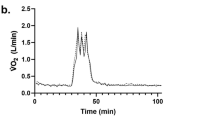Summary
To determine adaptation to prolonged exercise in paraplegics, maximal O2 uptake (\(\dot V_{O_{2max} } \)) and lactate threshold (LT) were evaluated during an arm cranking exercise in nine patients (P) and nine able-bodied (AB) subjects.
Mean \(\dot V_{O_{2max} } \) averaged 25.1 and 31.6 ml · min−1 · kg−1 in P and AB groups respectively. \(\dot V_{O_{2max} } \) in P was found to be directly related to the level of spinal injury: the higher the lesion the lower the uptake. Lactate threshold expressed as a percentage of \(\dot V_{O_{2max} } \) was higher in P (59%) than in AB (43%), and close to that observed in armtrained athletes.
Since training has less effect on \(\dot V_{O_{2max} } \) in paraplegics than in able-bodied subjects, attributable to a deficiency in the circulatory adaptation of paraplegics to exercise, the observed differences between AB and P in lactate threshold and submaximal exercise indicate that the possible effect of training in paraplegics is located at the level of intracellular chemistry, with a diminution in glycogenolysis (higher LT) and a higher rate of lipid utilization (lower RQ).
Similar content being viewed by others
References
Bar-Or O, Zwiren LD (1975) Maximal oxygen consumption test during arm exercise-reliability and validity. J Appl Physiol 38:424–426
Charbonnier J-P, Lacour J-R, Riffat J, Flandrois R (1975) Experimental study of the performance of competition swimmers. Eur J Appl Physiol 34:157–167
Costill DL, Coyle E, Dalsky G, Evans W, Fink W, Hoopes D (1977) Effect of elevated plasma FFA and insulin on muscle glycogen usage during exercise. J Appl Physiol 43:695–699
Coutts KD, Rhodes EC, McKenzie DC (1983) Maximal exercise response of tetraplegic and paraplegic. J Appl Physiol 55:479–482
Coutts KD, Rhodes EC, McKenzie DC (1985) Submaximal exercise responses of tetraplegics and paraplegics. J Appl Physiol 59:237–241
Davis JA, Vodak P, Willmore JH, Vodak J, Kurtz P (1976) Anaerobic threshold and maximal aerobic power for three modes of exercises. J Appl Physiol 41:544–550
Gass GC, Camp EM (1979) Physiological characteristics of trained Australian paraplegic and tetraplegic subjects. Med Sci Sports 11:256–259
Gollnick PD, Armstrong RB, Saubert CW, Piekl K, Saltin B (1972) Enzyme activity and fiber composition in skeletal muscle of untrained and trained men. J Appl Physiol 33:312–319
Henricksson J (1977) Training induced adaptation of skeletal muscle and metabolism during submaximal exercise. J Physiol (Lond) 270:661–675
Hjeltnes N (1977) Oxygen uptake and cardiac output in graded arm exercise in paraplegics with low level spinal lesions. Scand J Rehab Med 9:107–113
Hjeltnes N (1984) Control of medical rehabilitation of para and tetraplegics by repeated evaluation of endurance capacity. Int J Sport Med 5:171–174
Holloszy JO (1975) Adaptation of skeletal muscle to endurance exercise. Med Sci Sports 7:155–164
Jaeger-Denavit O, Lacert Ph, Grossiord A (1968) Etude de la consommation d'oxygène chez les paraplégiques et les tétraplégiques en fonction du niveau médullaire et des pertubations toniques. Rev Fr Et Clin Biol 13:277–284
Knuttson E, Lewenhaupt-Olsson E, Thorsen M (1973) Physical work capacity and physical conditioning in paraplegic patients. Paraplegia 11:206–216
Marincek CRT, Vojko V, Eng MS (1977) Arm cycloergometry and kinetics of oxygen consumption in paraplegics. Paraplegia 15:178–185
Nilsson S, Staff DH, Pruett EDR (1975) Physical work capacity and the effect of training on subjects with long standing paraplegia. Scand J Rehabil Med 7:51–56
Pollock ML, Miller HS, Linnerud AC, Laughridge E, Coleman E, Alexander E (1974) Arm pedaling as an endurance training regimen for the disabled. Arch Phys Med Rehabil 55:418–424
Rennie MJ, Holloszy JO (1977) Inhibition of glucose uptake glycogenolysis by availability of oleate in well-oxygenated perfused skeletal muscle. Biochem J 168:161–170
Reybrouck T, Heigenhause R, Faulkner JA (1975) Limitations to maximum oxygen uptake in arm leg and combined arm-leg ergometry. J Appl Physiol 38:774–779
Saltin B, Nazar K, Costill DL, Stein E, Jansson E, Essen B, Gollnick PD (1976) The nature of the training response: peripheral and central adaptations to one legged exercise. Acta Physiol Scand 26:289–305
Sawka MN, Glaser RM, Wilde SW, Von Luhrte TC (1980) Metabolic and circulatory responses to wheelchair and arm crank exercise. J Appl Physiol 49:784–788
Skrinar GS, Evans WJ, Ornstein LJ, Brown DA (1982) Glycogen utilization in wheelchair — Dependent athletes. Int J Sports Med 3:215–219
Tesch PA, Lindeberg S (1984) Blood lactate accumulation during arm exercise in world class kayak paddlers and strenght trained athletes. Eur J Appl Physiol 52:441–445
Zwiren LD, Bar-Or O (1975) Response to exercise of paraplegics who differ in conditioning level. Med Sci Sports 7:94–98
Author information
Authors and Affiliations
Rights and permissions
About this article
Cite this article
Flandrois, R., Grandmontagne, M., Gerin, H. et al. Aerobic performance capacity in paraplegic subjects. Europ. J. Appl. Physiol. 55, 604–609 (1986). https://doi.org/10.1007/BF00423204
Accepted:
Issue Date:
DOI: https://doi.org/10.1007/BF00423204




